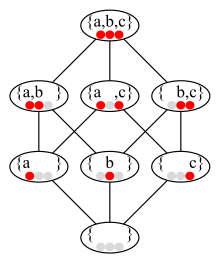File talk:Numbered 3-cube on side.svg
(Redirected from File talk:Cube diagram; octal numbers.svg)
Nodes numbered sub-optimally
[edit]Number cube nodes using (x,y,z) unit square value-set or represented as octal value for (x,y,z) Cube nodes numbering on (x,y,z) coordinate system would more useful if pictured and numbered as if in octal: Node: (x,y,z)...
Reconsider node numbering value-set:
Number cube nodes using (x,y,z) unit square value-set or represented as octal value for (x,y,z) Cube nodes numbering on (x,y,z) coordinate system would more useful if pictured and numbered as if in octal:
Node: (x,y,z) 000: (0,0,0) 001: (0,0,1) 002: (0,1,0) 003: (0,1,1) 004: (1,0,0) 005: (1,0,1) 006: (1,1,0) 007: (1,1,1) IrishLeprechan (talk) 10:06, 10 November 2016 (UTC)

- You are essentially saying, that big-endian is optimal, and little-endian is suboptimal. The advantage of little-endian is that it allows a consistent numbering of finite subsets of an infinite set. In the cube on the right I would enumerate {a} as 1, {b} as 2 and {c} as {4}. If suddenly {d} appeared, it would be clear that it is 16. With the "optimal" big-endian system {d} would become 1, and the enumeration of the first eigth subsets would have to be changed. BTW: For the same reason I enumerate finite permutations in reverse colexicographic rather than lexicographic order. Watchduck (quack) 16:49, 15 November 2016 (UTC)